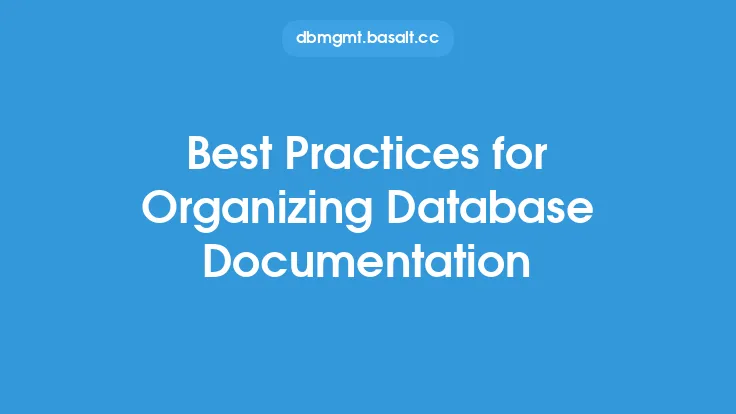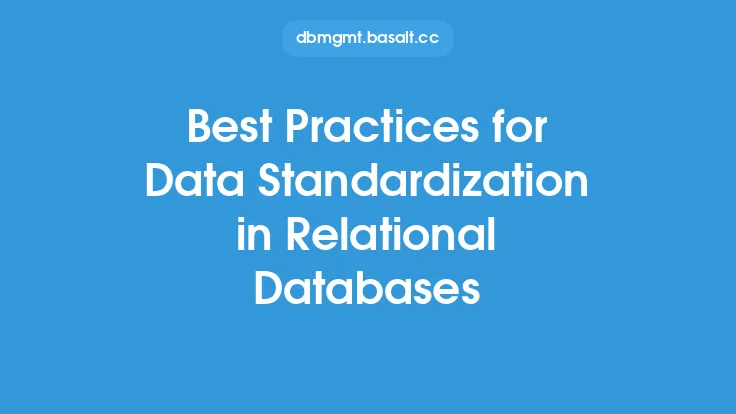Database standardization is a crucial aspect of database administration, as it enables organizations to establish a unified system that promotes consistency, efficiency, and scalability. A standardized database system ensures that all databases within an organization adhere to a set of predefined rules, guidelines, and best practices, making it easier to manage, maintain, and integrate data across different platforms and applications. In this article, we will delve into the best practices for achieving database standardization, highlighting the key benefits, challenges, and technical considerations involved.
Introduction to Database Standardization
Database standardization involves establishing a common framework for designing, implementing, and managing databases within an organization. This framework includes a set of standards, policies, and procedures that govern database development, deployment, and maintenance. The primary goal of database standardization is to ensure that all databases are consistent in terms of their structure, syntax, and semantics, making it easier to integrate data, share resources, and reduce costs. A standardized database system also facilitates better data governance, improved data quality, and enhanced data security.
Benefits of Database Standardization
The benefits of database standardization are numerous and significant. Some of the key advantages include:
- Improved data consistency and accuracy
- Enhanced data integration and sharing
- Increased efficiency and productivity
- Better data governance and compliance
- Reduced costs and improved resource utilization
- Improved scalability and flexibility
- Enhanced data security and reduced risk
- Simplified database management and maintenance
Key Components of Database Standardization
Database standardization involves several key components, including:
- Data modeling standards: These define the structure and organization of data within a database, including entity-relationship diagrams, data types, and data formats.
- Database design standards: These govern the physical design of a database, including table structures, indexing, and storage management.
- SQL standards: These define the syntax and semantics of SQL queries, including data types, functions, and operators.
- Data integrity standards: These ensure the accuracy, completeness, and consistency of data within a database, including data validation, data normalization, and data constraints.
- Security standards: These protect data from unauthorized access, including authentication, authorization, and encryption.
Best Practices for Database Standardization
To achieve database standardization, organizations should follow several best practices, including:
- Establish a database governance framework: This defines the policies, procedures, and standards for database development, deployment, and maintenance.
- Develop a data modeling methodology: This ensures that data is consistently modeled and organized across different databases and applications.
- Implement a database design framework: This governs the physical design of databases, including table structures, indexing, and storage management.
- Use standardized SQL syntax: This ensures that SQL queries are consistent and portable across different databases and platforms.
- Implement data integrity checks: This ensures the accuracy, completeness, and consistency of data within a database.
- Use encryption and access controls: This protects data from unauthorized access and ensures the confidentiality, integrity, and availability of data.
Technical Considerations for Database Standardization
Database standardization requires careful consideration of several technical factors, including:
- Database management systems: Different database management systems, such as Oracle, Microsoft SQL Server, and MySQL, have different features, functions, and syntax. Standardization efforts must take into account these differences and ensure that databases are designed and implemented to be compatible with multiple platforms.
- Data types and formats: Different databases and applications may use different data types and formats, such as integer, string, and date. Standardization efforts must ensure that data is consistently defined and formatted across different databases and applications.
- Character sets and collation: Different databases and applications may use different character sets and collation sequences, such as ASCII, Unicode, and UTF-8. Standardization efforts must ensure that data is consistently encoded and sorted across different databases and applications.
- Indexing and storage management: Different databases and applications may have different indexing and storage management requirements, such as indexing strategies, storage devices, and backup and recovery procedures. Standardization efforts must ensure that databases are optimized for performance, scalability, and reliability.
Challenges and Limitations of Database Standardization
Despite the benefits of database standardization, there are several challenges and limitations to consider, including:
- Legacy systems and applications: Existing databases and applications may not be compatible with standardized databases, requiring significant modifications or upgrades.
- Vendor lock-in: Different database vendors may have different features, functions, and syntax, making it difficult to standardize databases across multiple platforms.
- Data complexity and variability: Different databases and applications may have different data structures, formats, and semantics, making it challenging to standardize data across different platforms.
- Organizational and cultural barriers: Database standardization may require significant changes to organizational processes, policies, and culture, which can be difficult to implement and enforce.
Conclusion
Database standardization is a critical aspect of database administration, enabling organizations to establish a unified system that promotes consistency, efficiency, and scalability. By following best practices, considering technical factors, and addressing challenges and limitations, organizations can achieve database standardization and reap the benefits of improved data consistency, enhanced data integration, and increased efficiency. As data continues to play an increasingly important role in business decision-making, database standardization will become even more critical for organizations seeking to leverage their data assets to drive innovation, growth, and competitiveness.





